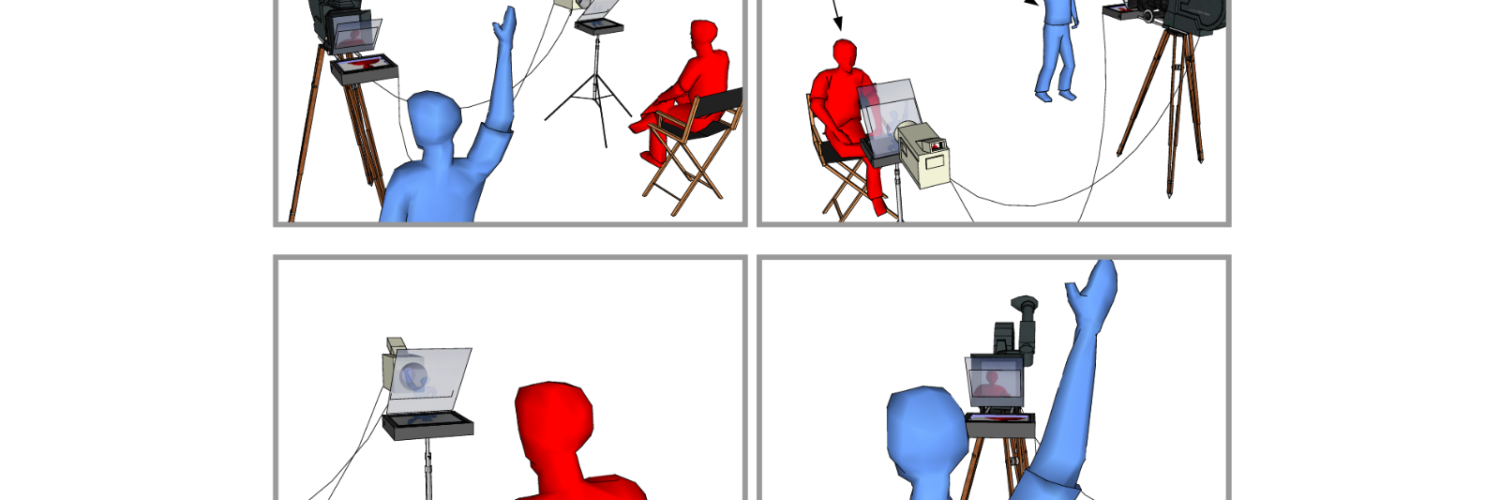by Lucy Kendra, Heriot-Watt Online, UK.
We often think of technology as working against the possibility of intimacy. But there are so many counter-examples. The telephone is a good counter-example. There are things we can say to each other on the phone that we would never say if we were in the same room. The Interrotron is like that. It creates greater distance and greater intimacy. And it also creates the true first person. Now, when people make eye contact with me, it can be preserved on film.
The Interrotron technique, popularised by documentarian Errol Morris, uses a two-way mirror (commonly found in autocues – also known as teleprompters) to project a live feed of the interviewer directly in front of the camera lens. The setup supports interviewees to feel a genuine connection – with the potential for direct eye contact – by interacting with a real person rather than staring into the impersonal ‘black hole’ of the camera. The name “Interrotron” is a playful portmanteau of “interview”, and the “terror” it can reduce for the interviewee. Morris discusses this technique in the April 2024 Chinwag podcast with Paul Giamatti and Stephen Asma. Earlier print interviews provide additional insights, including a self-conducted interview for FLM magazine (2004) and another with Paul Cronin. For a notable example of Morris’ Interrotron technique in action, his First Person television series is available to watch for free online. For links and contextual details, visit Colin Marshall’s post on the Open Culture website.
For a grounding in the original setup, Morris’ long-time collaborator, production designer Steve Hardie, provides detailed instructions, including illustrations, on his website, “to show how the concept works for those interested, and more pragmatically, as a reference for camera crews that work with Errol.” For more contemporary takes, Marcos Rocha’s tutorial offers a solid starting point. Meanwhile, remote setups are covered in online resources from Meet the Gaffer and Fitzroy Academy. Slate Roof Films and Zendesk also provide valuable reflections and practical guides, the latter also including a video highlighting the “delightful effect” the Interrotron has on people when they experience it first hand. The Interrotron technique is adaptable for smartphone or tablet cameras, and autocue devices are now available for a variety of budgets – and can even be home made. For those seeking ready-made solutions, Vox Box Air, Portaprompt, and Eye Direct offer Interrotron-inspired ‘out of the box’ options.

Once you grasp the basic concept, the Interrotron opens up numerous possibilities for media production in educational contexts. It’s particularly helpful when working with presenters who may be nervous or unfamiliar with speaking to audiences ‘through the lens.’ The interviewer can be combined – or swapped – with visual and text prompts. The role of the interviewer can also be filled by a director, coach, or supportive peer, while a dual setup can be used to create a mirrored experience – and recording – at both ends. Additionally, the technique can also be adapted to facilitate self-monitoring in real-time by reflecting a live feed of the presenter back to themselves. Incorporating secondary (non-Interrotron) camera angles further enhances production by offering editors more flexibility, freeing presenters from the pressure of delivering their content perfectly in one take.
At Heriot-Watt Online, the Interrotron has proven to be an invaluable tool, enabling our subject experts to achieve more natural, personable performances with greater speed and ease. This, in turn, enhances the overall learning experience for those engaging with the media. The technique aligns with our commitment to fostering a sense of connection for students studying remotely and asynchronously. Additionally, it’s been surprisingly budget-friendly, as we’ve managed to implement Interrotron setups using equipment already available in our production kit.
We – the digital media production team at Heriot-Watt Online, Edinburgh – encourage you to share with us your own Interrotron-inspired projects and experiences You can reach us all at our group account: hwomedia@hw.ac.uk.
[A demonstration of the Interrotron in action – by Lucy Kendra, Naomi Holwill and Kara Johnston, Heriot-Watt Online- took place at the Media and Learning Conference 2024]
Author
Lucy Kendra, Heriot-Watt Online, UK.














